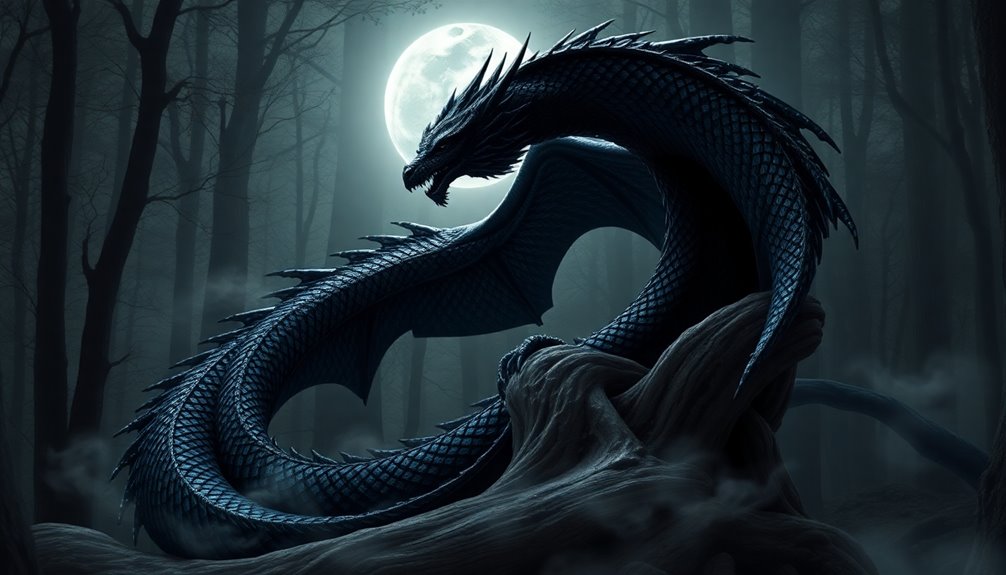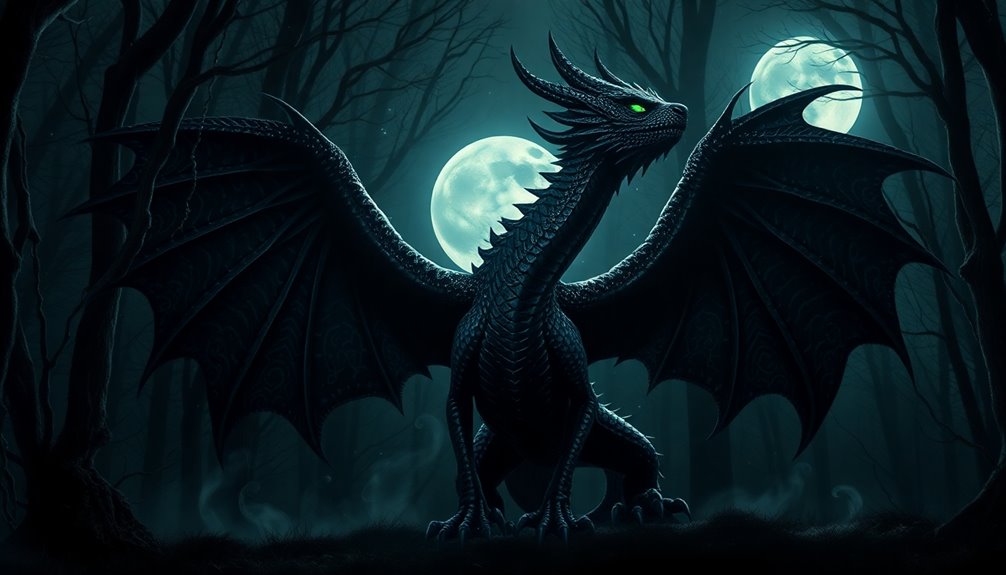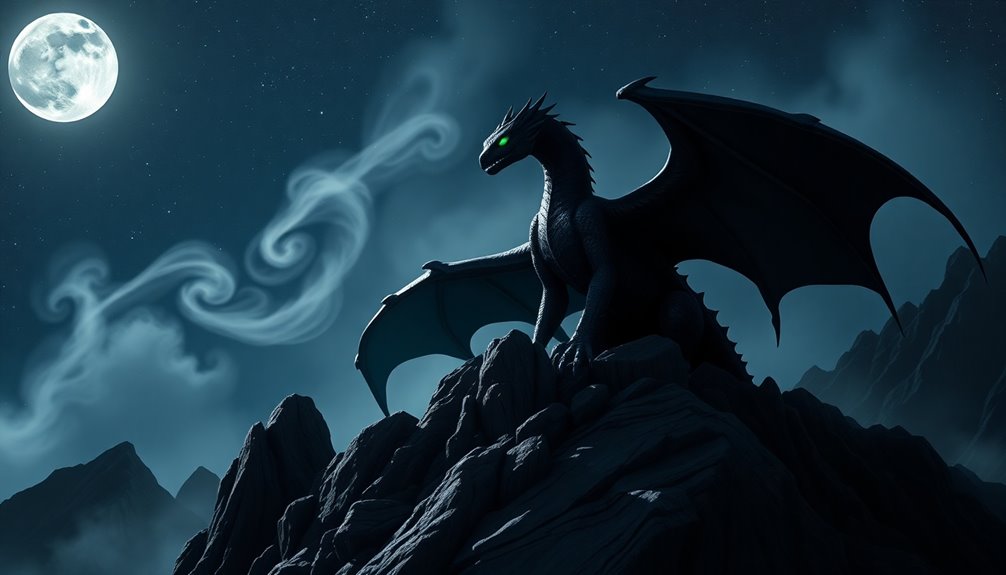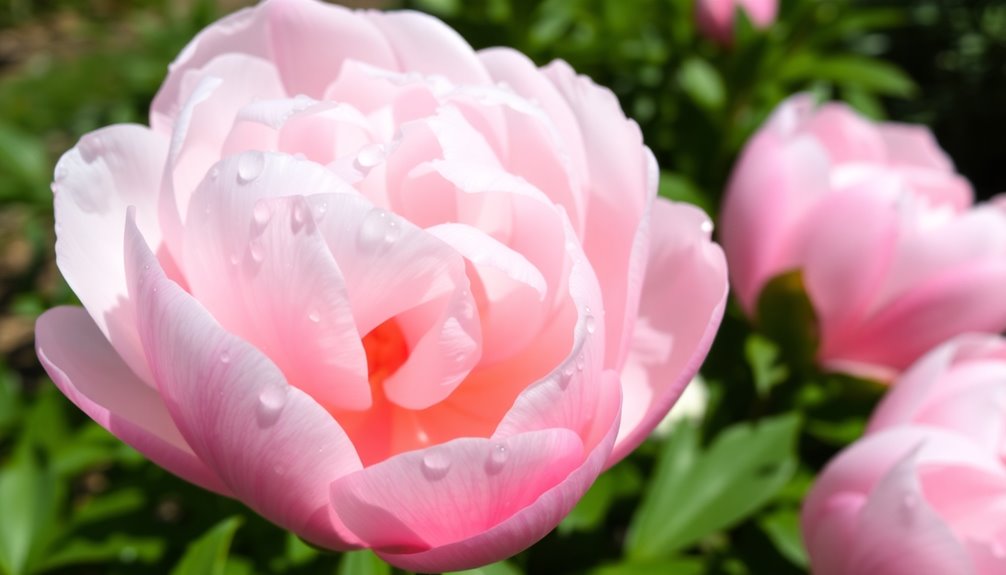A black dragon symbolizes a powerful blend of chaos, authority, and transformation. You'll see it as a representation of the shadow self, reflecting your deepest fears and complexities. In many cultures, these dragons embody both destructive and creative forces, highlighting the balance between life and death. They connect with the primal energy of nature, showcasing raw power. As you explore your inner chaos, black dragons encourage personal growth and self-discovery. Their mystique invites you to face your dark aspects for transformation. There's much more to uncover about their symbolism and significance that awaits you.
Key Takeaways
- Black dragons symbolize the balance between chaos and personal transformation, reflecting the duality of destruction and creation.
- In Western folklore, they embody evil and danger, representing humanity's fears of the unknown and unchecked power.
- Chinese culture views black dragons as powerful guardians of storms and water, highlighting their control over natural elements.
- They represent the shadow self, revealing inner darkness that leads to growth, strength, and spiritual enlightenment.
- Black dragons are symbols of authority and power, illustrating the nurturing versus annihilating aspects of life and transformation.
The Significance of Black Color

The color black holds deep significance across various cultures and contexts. It represents the absence of color, symbolizing the primordial void that existed before light emerged. This duality of black reflects its association with power and authority, often viewed as a symbol of dominance and humility. When you think of black dragons, you're tapping into this rich symbolism, as they embody strength and mystique.
In Western cultures, black is commonly linked to mourning, seen during funerals and events like Halloween. Yet, in other societies, black can represent more positive attributes, such as stability and emotional protection. In Feng Shui, for instance, black connects to the water element, indicating the potential for new beginnings.
Psychologically, black embodies the shadow aspect of the psyche in Jungian terms, representing chaos while also holding the key to personal transformation and self-discovery. This complexity enhances the allure of black dragons, marking them as powerful beings that invite you to confront your own shadows.
Consequently, black isn't just a color; it's a profound symbol of power that resonates deeply across cultures and contexts.
Cultural Interpretations of Black Dragons

When you explore the cultural interpretations of black dragons, you'll notice a stark contrast between Western and Chinese views.
In Western folklore, they're often seen as embodiments of evil, while in Chinese culture, they're powerful symbols of storms and water.
This duality highlights how different societies perceive the same creature in uniquely meaningful ways.
Western Evil Associations
Throughout Western mythology, black dragons are steeped in associations with evil, embodying danger and malevolence in countless tales. These creatures often serve as antagonists, representing chaos and destruction, as they challenge heroes in their quests.
You'll find that their fearsome reputation is amplified by their ability to blend into darkness, making them formidable foes in battle.
In literature and folklore, black dragons symbolize the shadow aspect of the psyche, reflecting the darker, chaotic elements of existence. They embody humanity's fears of the unknown, revealing the moral struggles between good and evil.
When you encounter a black dragon in a story, it often represents the consequences of unchecked power and the potential for corruption that lies within.
These dragons don't just frighten; they also provoke thought. They make you consider the duality of existence, the constant battle between light and dark.
Their evil associations remind you that danger can lurk in the shadows, waiting to manifest itself. In this way, black dragons remain potent symbols of the darker sides of human nature and the complexities of morality.
Chinese Storm Symbolism
While many cultures view dragons through a lens of fear and destruction, Chinese mythology offers a more nuanced perspective on black dragons, particularly regarding their connection to storms. In this regard, black dragons symbolize the raw power and control over natural elements, especially during lightning storms.
You'll find that these dragons embody the chaotic aspects of nature, representing the unpredictable forces that can both devastate and renew the environment.
As storm symbols, black dragons highlight the duality of destruction and rebirth. When storms rage and heavy rains fall, they can lead to flooding, yet they also nourish the earth, facilitating agricultural growth. This relationship underscores the importance of black dragons in Chinese culture, where they're revered for their ability to harness storm energy, making them essential for communities reliant on favorable weather.
Additionally, black dragons serve as guardians against natural disasters, embodying protective qualities that resonate deeply within folklore. Their presence signifies not only the tumult of storms but also the transformative potential that follows, reminding you of the delicate balance between chaos and renewal inherent in nature.
Psychological Aspects of Darkness

Darkness often evokes a mix of fear and fascination, serving as a powerful symbol in the psychological domain. In Jungian psychology, black embodies the shadow aspect of the psyche, representing both chaos and the potential for self-discovery.
When you explore the psychological aspects of darkness, consider these three key themes:
- Duality: Darkness showcases the interplay between creation and destruction, highlighting your inner strength and self-confidence.
- Unpredictability: Black symbolizes the germinal state of creation, reflecting the unpredictable nature of existence and your unconscious mind.
- Confrontation: Engaging with your personal shadows can lead to growth, as black embodies both the fear of the unknown and the potential for transformation.
In this light, darkness becomes a complex symbol of mourning and authority, representing the layers of your psyche.
By embracing these psychological aspects, you can confront your fears and release deeper insights about yourself.
Ultimately, the exploration of darkness isn't just about fear; it's an invitation to harness the chaos within for personal growth and understanding.
Characteristics of Black Dragons

Black dragons embody immense power, chaos, and creation, making them one of the most complex symbols in mythology.
They reflect the psychological shadow aspect of humanity, reminding you of the unpredictable forces at play in life, death, and rebirth.
Understanding these characteristics can help you grasp the deeper meanings behind their presence in various cultures.
Symbol of Power
Throughout various mythologies and cultures, black dragons stand out as symbols of unparalleled power and dominance. They embody the pinnacle of strength within the dragon hierarchy, making them formidable figures that command respect and fear.
You'll notice that their symbolism can be distilled into three key aspects:
- Embodiment of Evil: In Western European folklore, black dragons represent the darker facets of authority, often symbolizing incarnated evil and danger.
- Elemental Forces: In Chinese mythology, they're associated with lightning storms during battles, showcasing their fierce presence in nature's elemental domain.
- Strategic Advantage: Their ability to camouflage in darkness gives black dragons a unique edge, allowing them to strike with precision as powerful adversaries.
Black dragons also reflect the duality of the psyche, representing both creative and destructive power within individuals.
This complexity adds to their allure, as they symbolize not just raw strength but the potential for transformation.
When you think of black dragons, consider how they encapsulate the essence of power in its most profound and multifaceted form.
Chaos and Creation
Often viewed as the embodiment of chaos, black dragons seamlessly intertwine the forces of destruction and creation. In many cultures, these formidable creatures represent the unpredictable nature of life, demonstrating how chaos can lead to both devastation and renewal.
With their deep association with lightning storms in Chinese mythology, they highlight the raw power of nature, reminding you that from turmoil often arises transformative energy.
In Western European folklore, black dragons are frequently depicted as antagonists, symbolizing the lurking dangers that exist in shadows. Yet, this portrayal doesn't negate their potential for good fortune.
Embracing the duality of these dragons allows you to understand that chaos can be an essential part of the creative process. Just as a black dragon camouflages itself in darkness, you might find that embracing uncertainty can enhance your own adaptability and stealth in maneuvering challenges.
Recognizing the traits of black dragons can inspire you to harness chaos as a catalyst for growth, leading to newfound insights and opportunities.
In this way, the black dragon's essence reflects the intricate balance between destruction and creation, urging you to welcome both aspects in your journey.
Psychological Shadow Aspect
Within the domain of Jungian psychology, black dragons symbolize the shadow aspect of your psyche, representing the hidden and chaotic elements that reside within. Embracing these aspects can lead to profound personal growth and transformation.
When you confront your inner darkness, you unleash the potential for strength and self-confidence. Here are three key characteristics of black dragons as they relate to this psychological shadow aspect:
- Cyclical Nature: Black dragons embody themes of life, death, and rebirth, emphasizing that every ending can birth a new beginning.
- Fertile Unconscious: They highlight the unpredictable and fertile aspects of your unconscious mind, revealing the germinal state of creation that thrives beneath the surface.
- Creativity and Destruction: The duality of black dragons captures the interplay between creativity and destruction, reminding you that embracing your shadow is essential for holistic self-discovery.
Black Dragons in Mythology

Black dragons loom large in the tapestry of mythology, embodying a complex blend of fear and fascination. In Western tales, these mythical creatures often symbolize incarnated evil and danger, representing formidable forces that heroes must confront. Their shadowy presence evokes a sense of dread, making them iconic antagonists in folklore.
In contrast, Chinese dragons carry a different significance. Here, black dragons are associated with lightning storms during battles, showcasing the chaotic and unpredictable elements of nature. This connection emphasizes their role as powerful agents of transformation and disruption. Their ability to camouflage in darkness grants them an advantage in physical confrontations, making them both awe-inspiring and terrifying to their adversaries.
The duality of black dragons reflects the interplay between creation and destruction, light and darkness. They embody not just malevolence but also the essential chaos of life, death, and rebirth.
In Jungian psychology, these dragons symbolize the shadow aspect of the psyche, urging you to confront the complexities within yourself. Hence, black dragons serve as potent reminders of the intricate balance between fear and fascination, chaos and order in our lives and stories.
Symbolism of Power and Authority

Dragons wield immense power and authority across various cultures, with black dragons standing out as the ultimate embodiment of this dominion. They represent the pinnacle of their kind, often evoking feelings of respect and fear.
When you think about the symbolism of black dragons, consider these key points:
- Dominion Over Spheres: Black dragons embody absolute authority, reigning over the physical sphere with an unmatched presence.
- Stealth and Strength: Their ability to camouflage in darkness highlights their stealth, enhancing their authoritative role in their environments.
- Creation and Destruction: These creatures illustrate the complex duality of power, capable of both nurturing and annihilating, which reflects their intricate relationship with authority.
In Western mythology, black dragons are frequently associated with evil and danger, reinforcing their formidable nature.
This dark mystique not only commands respect but also emphasizes their chaotic aspects, as seen in Jungian psychology. Consequently, the black dragon serves as a powerful symbol of authority, embodying the profound complexities of life and the weight of dominion it carries.
Embracing this symbolism can deepen your understanding of power and its far-reaching effects.
Embracing the Shadow Within

Embracing your shadow can be a transformative journey that leads to profound self-discovery. The black dragon, a powerful symbol in Jungian psychology, represents this shadow aspect of your psyche, urging you to confront the unconscious and repressed elements of your personality. By doing so, you might indicate a willingness to explore the chaotic elements of life, which reflect both creation and destruction.
Facing your inner darkness isn't just about acknowledging fears; it's about uncovering hidden wisdom. This wisdom can guide you through the unpredictable nature of existence, helping you navigate its complexities. The black dragon encourages you to recognize that within chaos lies the potential for growth and transformation.
As you embrace your shadow, you tap into the germinal state of creation, allowing for greater creativity and resilience in your life. This mystical journey into your personal shadows can lead to spiritual enlightenment and a deeper understanding of who you are.
Frequently Asked Questions
What Does the Black Dragon Symbolize?
When you think about the black dragon, it symbolizes the depths of the subconscious and the mystery of transformation.
It's often linked to protection and hidden wisdom. In Western cultures, you might see it as a representation of chaos and danger.
Conversely, in Chinese mythology, the black dragon's associated with weather control and nature's power.
Ultimately, it embodies the duality of life, showcasing both strength and the transformative aspects of your inner darkness.
What Does the Black Dragonflight Represent?
The Black Dragonflight represents chaos, power, and the darker aspects of existence.
When you explore their nature, you'll see they embody the duality of creation and destruction. They reflect the lurking shadows within you, illustrating the balance of your creative and destructive forces.
Often depicted as cunning and manipulative, they remind you that your journey involves steering through unpredictable emotions and experiences, ultimately leading to deeper self-discovery and understanding of your own psyche.
What Does a Dragon Symbolize Spiritually?
When you think of a dragon, imagine a powerful guardian soaring through the clouds, fierce yet wise.
Spiritually, dragons symbolize transformation and inner strength, urging you to embrace your potential. They represent the balance between chaos and order, guiding you through life's challenges.
As you confront fears and shadows within, the dragon's spirit inspires you to grow, reminding you that true power lies in understanding yourself and the world around you.
What Does the Dragon Symbolize in the Slaying of the Dragon?
When you consider the slaying of a dragon, it symbolizes your triumph over great challenges. It represents the battle between good and evil, showcasing personal growth as you conquer formidable fears.
By defeating the dragon, you restore order and balance, confronting chaos in your life. This act also signifies a quest for knowledge and enlightenment, often leading to transformation and renewal.
Ultimately, it's about embracing your journey toward self-discovery and empowerment.
Conclusion
In exploring the symbolism of black dragons, you uncover a tapestry woven with power, mystery, and the duality of light and dark. Just like the night sky, these creatures invite you to embrace your own shadows, reminding you that darkness can be a source of strength. By understanding these themes, you can transform fear into wisdom, allowing the black dragon to guide you on your journey of self-discovery and empowerment. Embrace the mystique and let it inspire you!











